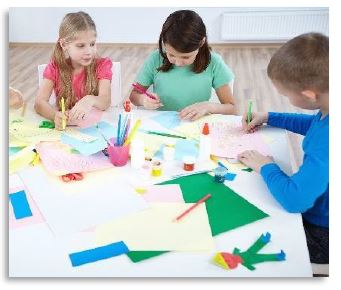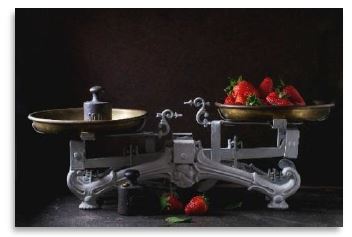Introduction
Math is everywhere, and it's more than just learning numbers. When children sort crayons by color, put puzzles together, build with blocks, count their raisins during snack, or sing "Five Little Monkeys Jumping on the Bed," they are learning about math. These kinds of hands-on learning activities create a solid foundation for children to understand shapes, sizes, length, addition and subtraction.
Children who have the opportunity to learn math-related concepts in early childhood often do better in school and are more skilled at using math as adults. Preschool teachers can create a setting that fosters children being eager to learn and explore math. High-quality child care programs provide young children with many opportunities to sort and classify, find similarities and differences, measure and estimate, and solve problems.
In this fact sheet we focus on three fundamental math skills — spatial relations, geometry (shapes) and measurement.
Spatial Relationships
Spatial relationships explore the concept of where objects are in relationship to something else. For example, a ball may be behind the chair, or under the table, or in the box. The dog may be on the blanket, outside of the house, or in the doghouse. These types of words are sometimes called position words because they suggest the position of an object in relation to something else. Learning to understand spatial relationships helps children talk about where things are located.
Ideas to try:
Use Position Words: Use position words as you talk with children to teach them spatial concepts. For example, “You will find the ball under the table.” Some common position words to say with young children include: above/below, before/after, high/low, in front of/in back of, inside/outside, on top of/under, forward/backward, up/down, to/from and near/far. Children learn through repetition. Use these words often to help them learn the meaning of each word.
Hide and Seek: To help children practice spatial relationships, hide a toy in the room, and give directions on how to find the toy using position words. For example, you might say, "Look behind the chair." Give children blocks and have them think of places to hide their blocks. Have them use position words to help others find the blocks.
Put the Block ____: Give each child a large building block. Have children place blocks on top of, under, next to, inside, behind or in front of tables and chairs in the room. Give directions, such as, “I want Jan to put her block inside a box.” “Alexander should put his block under a table.” Continue until all the children have had a turn.
Obstacle Course: Create an obstacle course for children where they have to climb over a cushion, under a table, around a cabinet, through a tunnel and so forth. Let children try the obstacle course and use position words to describe what they are doing as they make their way through the obstacle course.
Spatial Simon Says: Play Simon Says using position words. Have children follow instructions, such as “stand in front of the door,” “go out the door,” “come in the door,” “climb under the table,” “stand behind the table,” “stand next to the cabinet,” “put the ball inside the box,” etc. Let children take turns being Simon and using position words to give instructions.
Geometry
Some child care providers may think of geometry as an advanced math concept learned in high school, however, even young children are aware of basic concepts related to shapes. Understanding shapes is fundamental to understanding geometry. As children start to identify shapes, they develop a beginning understanding of geometry.
Most preschool children are beginning to learn the names of basic two-dimensional shapes, such as circle, square, triangle and rectangle. Some preschoolers can even learn to recognize and name more complex shapes (rhombus, trapezoid or hexagon) and three-dimensional shapes (cube, sphere and pyramid).
Ideas to try:
Shape Pictures: Give children pieces of colorful paper cut into basic shapes—circles, squares, triangles and rectangles. Let them glue the various shapes onto a piece of paper to create their own shape picture.
Shape Puzzles: Glue a picture from a magazine to a piece of thin cardboard. Cut various shapes (circles, triangles and squares) out of the cardboard picture. Have children find the correct shaped pieces to complete the picture.

Block Play: The block area is a great place to reinforce children's knowledge of shapes. As you build a structure together, encourage the child to add a specific shape. You might say, "The top of this column looks like a great place to add a half-circle. What do you think?"

Fishing for Shapes: Cut construction paper or thin cardboard into circles, squares and triangles. Attach a paper clip to each shape. Tie a magnet to the end of a 25-inch-long piece of string. Tie the other end of the string to the dowel. Spread the shapes on the floor and have children use the magnet fishing pole to “catch” them. Have the children tell you what shape they caught. If this activity is difficult for younger children, you can adapt the activity by having the children place the magnet directly on the shape.
Shape Walk: Take a walk with the children and have them look for things that have common shapes, such as wheels (circle), yield sign (triangle) and windows (square). Keep track of the number of each shape found on a sheet of paper.
Measurement
Measurement is determining the size, amount or degree of something. For example, children can measure a block in many ways: height, weight, length and even temperature. The preschool years are the time children become familiar with important measurement concepts, such as amount (more/less), length, distance, size, weight, volume and time. Understanding these concepts is fundamental to later math success.
Ideas to try:
What Does it Weigh?: Using a standard kitchen scale, have children weigh common classroom objects (blocks, crayons, jars, books, rocks, feathers, toy trucks, etc.). Keep track of the weights on a large sheet of paper. Afterwards, have children tell you which items were heavier and which were lighter. Give children two different items and have them guess which is heavier. Then have them weigh both items to find out.

Sponge Toss: On a warm day, allow children to use wet sponges to see how far they can toss the sponges. Have them count their steps to measure how far they tossed the sponges. Children can compare the distance they can toss different sizes of wet sponges. Children can squeeze out most of the water and see how that affects how far the sponges go when tossed. Have them keep track of the distances on a large sheet of paper (similar to the table below).
How Much Does it Hold?: Collect empty jars of various sizes and shapes. Let children explore and compare how much water each container holds by pouring water from one jar to another. Have them keep track of which jars hold the most water and which ones hold the least.
How Many Steps?: Have children walk to various parts of the classroom or the outside play area. Have them count their steps as they go. Challenge the children to try walking with shorter steps compared to longer steps. Keep track of distances on a large sheet of paper. Younger children may need help counting.

Conclusion
Providing opportunities for children to explore and practice their beginning math skills helps set a strong foundation for the more advanced math skills they will encounter in school. Make the most of opportunities to help children learn about spatial relationship, basic geometry and measurement. Through play, children can learn that math is fun and get a head start toward elementary school.
Fun Books to Share
Dodds, D. Illustrated by J. Lacome. The Shape of Things. Scholastic.
Rosa-Mendoza, G. Illustrated by A. Ochoa. Lupe Lupita, Where Are You? Me+Mi Publishing.
Carter, D. A. How Many Bugs in a Box? Little Simon.
Tompert, A. Illustrated by L. M. Munsinger. Just a Little Bit. Scholastic.
References
Copley, J. V. (2010). The Young Child and Mathematics (2nd ed). Washington, DC: NAEYC. Dauksas, L., & White, J. (nd). Discovering Shapes and Space in Preschool. NAEYC.
Shilladya, A. (ed). (2012). Spotlight on Young Children: Exploring Math. Washington, DC: NAEYC.


